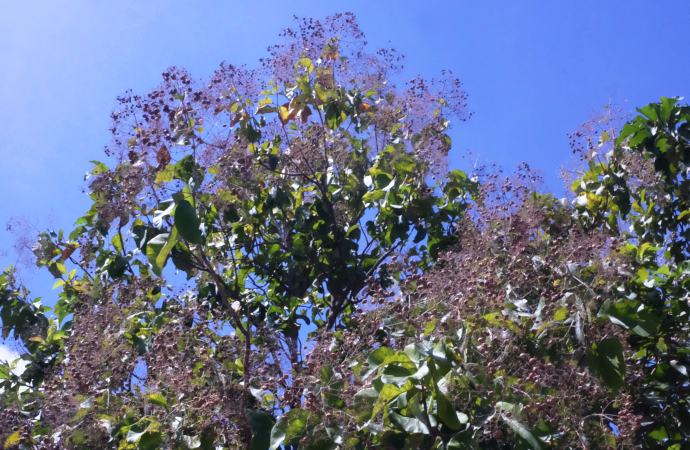Don’t see any kids throwing stones. What’s are those hard things hitting the zinc roof of the bus stop? Photo by Eric Jackson.
The sounds and silences of teak
by Eric Jackson
This teak tree, probably planted long ago as part of somebody’s fence line, is dropping its hard fruit. It does not, however, mean a quick and easy spread of new teak trees. The fruit are basically seeds with a thick outer covering – pericarp – that will leave the seeds dormant for a long time, usually years, if left to themselves. A process of repeated wetting and drying of teak fruit is needed to get the seeds ready to germinate and transplant.
This tree is in a mixed secondary growth forest fragment. Birds and animals will eat the fruit and seeds of other plants nearby, but you never see them eating teak fruit. The trees are native to south and southeast Asia, and nothing in Panama’s natural environment will eat them. If you walk into a planted teak forest here the silence is noteworthy – the wildlife doesn’t eat or nest there.
For a number of years there was a lot of noisy hype aimed mostly at foreigners about investing in teak plantations in Panama to get rich. The wood does have some value but our climate conditions were such that it was not as good as the Asian product. The problem was that Panama had too short a dry season to produce the best quality of logs.
Will this El Niño drought presage a more permanent change in our seasons? Might this raise the value of Panamanian teak? Surely you could find some hustler to tell you that, but it would be a risky bet, a ticket in a years-from-now lottery.
Contact us by email at fund4thepanamanews@gmail.com
To fend off hackers, organized trolls and other online vandalism, our website comments feature is switched off. Instead, come to our Facebook page to join in the discussion.
These links are interactive — click on the boxes












